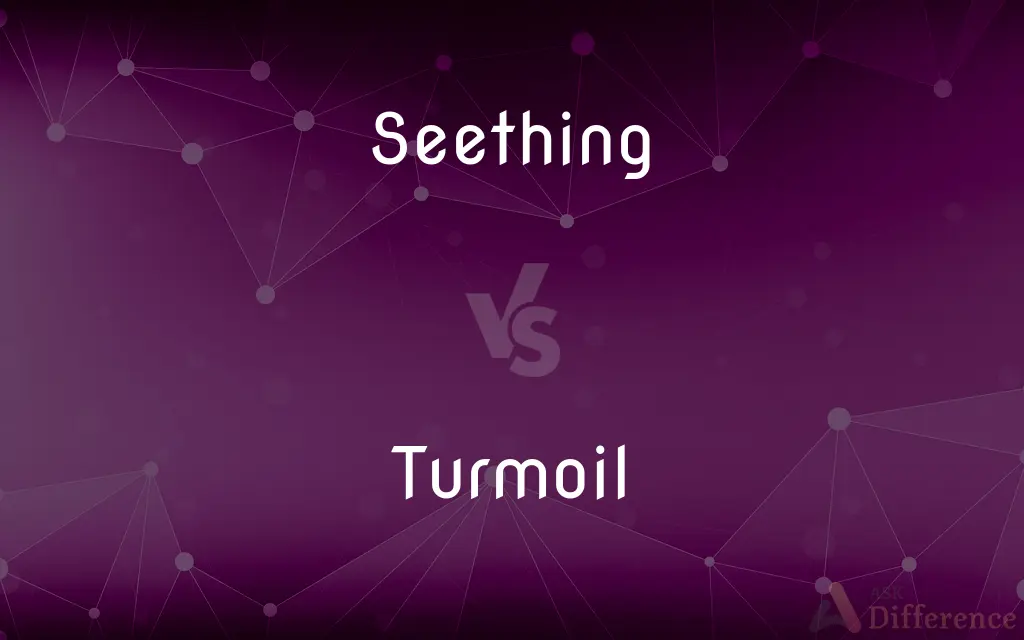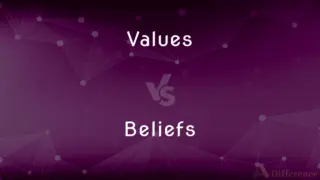Seething vs. Turmoil — What's the Difference?
By Tayyaba Rehman — Published on October 28, 2023
Seething refers to intense but unexpressed anger, while turmoil indicates a state of great disturbance, confusion, or uncertainty. They differ in focus: internal emotion vs. external disorder.

Difference Between Seething and Turmoil
Table of Contents
ADVERTISEMENT
Key Differences
Seething is a term usually used to describe a state of extreme but often suppressed anger or emotion. It's an internal, bubbling rage that might not be overtly visible. Turmoil, however, refers to a state of great disturbance, confusion, or uncertainty, possibly involving chaotic external circumstances or emotional upset. Turmoil is generally more visible and pervasive, affecting the environment or the individual’s mental state, and is not necessarily suppressed.
Seething generally denotes a simmering intensity, suggesting emotions kept under the surface, ready to explode. It's like a boiling pot with a lid on, symbolizing contained fury or agitation. On the other hand, turmoil is likened to a storm, indicating chaotic, uncontrolled disturbances. It is a broad term that could be applicable to various situations, such as emotional, political, or social unrest, and it implies a lack of control or stability.
The word seething can also imply an intense, swirling motion, depicting something in a state of agitation or tumult, often used metaphorically to represent emotions. It primarily signifies internal experiences and emotional states. Conversely, turmoil can relate to both internal states of mind and external situations. It is a versatile word, depicting anything from emotional struggles to widespread pandemonium, and it emphasizes disorder and disruption.
In literary usage, seething is often associated with imagery of boiling, bubbling, or simmering, symbolizing latent or suppressed emotions, particularly anger or rage. It’s a more subjective and internalized term. Turmoil, conversely, is depicted with imagery of storms, upheavals, or chaos, representing external or internal disorder, disruption, and confusion. It's a more objective term, describing observable states of disturbance and upheaval.
Comparison Chart
Definition
Intense but usually suppressed anger or emotion
State of great disturbance, confusion, or uncertainty
ADVERTISEMENT
Focus
Primarily internal, emotional
Can be internal or external, involves disorder
Expression
May not be overtly expressed or visible
Generally visible and pervasive
Usage
More subjective, relates to individual feelings
More objective, can describe various situations
Literary Imagery
Boiling, simmering, bubbling
Storms, upheavals, chaos
Compare with Definitions
Seething
Seething can depict emotions in a tumultuous, swirling state.
The injustice had her mind seething with thoughts of retaliation.
Turmoil
Turmoil is often associated with disruptions, upheavals, and pandemonium.
The sudden news plunged the community into turmoil and despair.
Seething
Seething often implies unexpressed, simmering anger or discontent.
Julie sat seething, frustrated by her inability to speak out.
Turmoil
Turmoil symbolizes a lack of stability and control in various situations.
She felt an inner turmoil, torn between her duties and desires.
Seething
Seething is the expression of intense but usually suppressed anger.
John was seething with rage after the unfair decision.
Turmoil
Turmoil implies chaotic, uncontrolled disturbances and disorder.
His mind was in turmoil, grappling with the overwhelming information.
Seething
Seething signifies bubbling or boiling emotions, ready to erupt.
His comments left the entire room seething in silent anger.
Turmoil
Turmoil can refer to both internal emotional struggles and external upheaval.
The economic turmoil affected millions, causing widespread distress.
Seething
Seething is a small village in Norfolk, England, about 91⁄2 miles south east of Norwich. Known as 'Seechin' in Tudor England, it covers an area of 6.78 km2 (2.62 sq mi) and had a population of 341 in 141 households at the 2001 census, the population increasing to 365 at the 2011 Census.Its church, St Margaret, is one of 124 existing round-tower churches in Norfolk.
Turmoil
A state of extreme confusion or agitation; commotion or tumult
A country in turmoil over labor strikes.
Seething
To churn and foam as if boiling.
Turmoil
A state of great disorder or uncertainty.
Seething
To be in a state of turmoil or ferment
The nation seethed with rebellion.
Turmoil
Harassing labour; trouble; disturbance.
Seething
To be violently excited or agitated
I seethed with anger over the insult.
Turmoil
To be disquieted or confused; to be in commotion.
Seething
Filled with unexpressed anger, the state of being livid.
Turmoil
To harass with commotion; to disquiet; to worry.
Seething
Boiling, bubbling
Turmoil
Harassing labor; trouble; molestation by tumult; disturbance; worrying confusion.
And there I'll rest, as after much turmoil,A blessed soul doth in Elysium.
Seething
The action of the verb to seethe.
Turmoil
To harass with commotion; to disquiet; to worry.
It is her fatal misfortune . . . to be miserably tossed and turmoiled with these storms of affliction.
Seething
Present participle of seethe
Turmoil
To be disquieted or confused; to be in commotion.
Seething
In constant agitation;
A seething flag-waving crowd filled the streets
A seething mass of maggots
Lovers and madmen have such seething brains
Turmoil
A violent disturbance;
The convulsions of the stock market
Seething
Seething can represent a state of extreme internal agitation.
After the argument, she was left seething, unable to calm down.
Turmoil
Violent agitation
Turmoil
Disturbance usually in protest
Turmoil
Turmoil is a state of great disturbance, confusion, or uncertainty.
The country was in turmoil following the unexpected political changes.
Common Curiosities
Can turmoil be internal?
Yes, turmoil can represent both internal emotional struggles and external disturbances.
Is seething always visible?
No, seething often implies internal, suppressed emotions and may not be overtly visible.
Does seething always refer to anger?
Primarily, but it can also depict other intense, suppressed emotions or agitations.
How is turmoil defined?
Turmoil is defined as a state of great disturbance, confusion, or uncertainty.
Is seething an active state?
Yes, seething implies active, intense emotional agitation, often simmering beneath the surface.
Can turmoil be widespread?
Yes, turmoil can affect large groups, communities, or even entire countries, especially in times of crisis.
Can turmoil be resolved quickly?
Resolving turmoil might require addressing and solving the underlying issues, which can take time.
Is turmoil always negative?
Typically, yes, turmoil usually denotes negative states of disorder and confusion.
Can turmoil be controlled?
It can be challenging, but resolving underlying issues can mitigate turmoil.
What does seething mean?
Seething refers to intense but usually suppressed or unexpressed anger or emotion.
Can seething affect one’s behavior?
Absolutely, seething, if not managed, can influence behavior, potentially leading to negative actions.
Does turmoil imply a lack of control?
Yes, turmoil usually implies a chaotic, uncontrolled state of disturbance and confusion.
Is addressing seething essential?
Yes, addressing and managing seething emotions is crucial to prevent harmful outbursts and maintain well-being.
Can seething lead to an outburst?
Yes, seething emotions can eventually erupt if not addressed or managed.
Is seething a common human experience?
Yes, experiencing seething emotions at some point is common, particularly when facing injustice or frustration.
Share Your Discovery

Previous Comparison
Stock Dividend vs. Stock Split
Next Comparison
Values vs. BeliefsAuthor Spotlight
Written by
Tayyaba RehmanTayyaba Rehman is a distinguished writer, currently serving as a primary contributor to askdifference.com. As a researcher in semantics and etymology, Tayyaba's passion for the complexity of languages and their distinctions has found a perfect home on the platform. Tayyaba delves into the intricacies of language, distinguishing between commonly confused words and phrases, thereby providing clarity for readers worldwide.













































